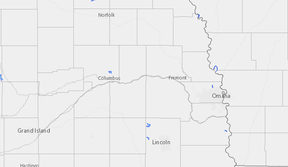Using the National Oceanographic and Atmospheric Administration’s Office of Water Prediction map students should identify the closest stream to your own home. Once you have found that, you should use the map to try and trace the route that water from that stream would take all the way to a sea, ocean, or gulf. (For example: Elkhorn River into Platte River, into the Missouri River, to the Mississippi River, to the Gulf of Mexico). For more information on watersheds, drainage basins, and how water moves through streams use the Watersheds and Drainage Basins website (https://www.usgs.gov/special-topics/water-science-school/science/watersheds-and-drainage-basins) put together as part of the Water Science School of the USGS.
Once you have completed your downstream trace, you will group up with other students who had the same closest stream and check each other’s work to ensure you all came up with the same pathway.
Once all groups are complete, we will work as a full group to discuss the following questions
- Describe the route that water from your own community takes once it moves downstream.
- Predict: Why is this type of information important to know when trying to understand stream health and water quality?
| Lesson Objectives:
|

 RSS Feed
RSS Feed
